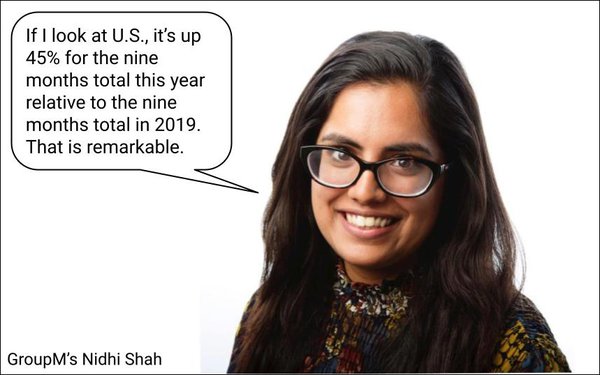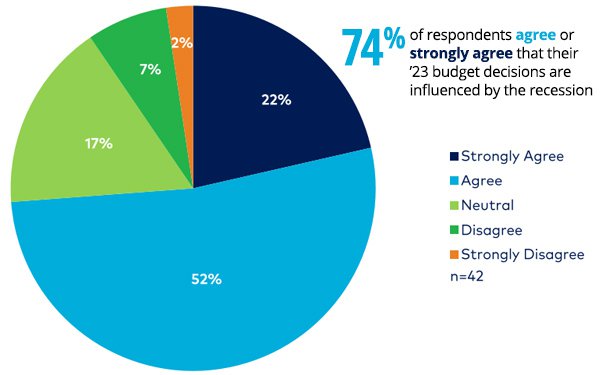As we move into October, two questions seem to be on everyone’s lips: “Didn’t the summer go by quickly?” and “Doesn’t it seem like holiday preparation starts earlier every year?”
The first is an annual lament, with no solution. The second is clearly accurate, especially this year. Consider the results of a survey of social media users conducted by Twitter this past May, which found that:
- Nearly one-third of people on Twitter said they expect to start thinking of holiday shopping ideas earlier this year than last.1
- While a quarter of people on Twitter said they expect to do their gift shopping earlier this year than last, 37% said they expect to have made most of their purchases before mid-November, while only 8% said they’ll still be shopping in mid- to late December.2
These trends have been borne out by Twitter’s own experience, which showed that holiday-related tweets in May and June of this year were 67% higher than during the same period in 2021.3 In addition, the surge of last-minute shopping-related tweets close to Christmas Eve that had been commonplace before 2020 had decreased by 22% by 2021.
Holiday-related tweets in May and June of this year were 67% higher than during the same period in 2021.
Why It’s Different This Year
While this may seem more like an evolution than a sea change in how shoppers—and brands—approach the holiday season, this year there are some key differences.
Chad Tully, industry director at Twitter, puts these trends into the context of how holiday-based Twitter conversations—and ads—have grown over the past decade, focused primarily on two aspects of the shopping experience: inspiration and deals. When it comes to inspiration, Twitter’s survey showed that at least a quarter of people on Twitter use the platform to find gift ideas, while 60% reported that Twitter is a critical influence in helping them decide what they’re buying for the holidays. The deals—which at least a third of people on Twitter expect to find via the platform—have always come to a peak during the two primary shopping days of the season: Black Friday and Cyber Monday.4
But this year, with inflation on consumers’ minds (and with conversations on Twitter about inflation increasing by 29% year over year this May and June5), early deals are clearly more important. Fearing further price increases, shoppers have started purchasing gifts sooner, before inflation can get the better of their budgets. That rush to purchase has been exacerbated by supply chain issues, which have put on-time gift delivery in jeopardy. “Countless brands have been challenged in that space,” Tully notes, adding that some, such as Home Depot, have even bought their own ships in order to try to circumvent delivery issues. With these potential impediments, consumers can’t risk waiting until the last minute this year, lest their gifts be out of reach, in terms of both price and availability.
The Perfect Storm
The combination of these macroeconomic factors has created something of a perfect storm.
As a result, if by May, consumers were starting to think about holiday gifts and were already on the hunt for inspiration6, now that it’s October, the shopping has begun in earnest, with consumers looking to lock in prices and make sure they’ll have gifts in hand when the holidays arrive.
That means, the Twitter data suggests, that if savvy shoppers are ready to buy in October, savvy brands need to be sharing ideas, crafting offers, and placing ads by that point as well.7 As Tully explains it, “There’s an interesting convergence of what’s happening in the retail sector. Conversations around shopping and commerce on Twitter are starting earlier than ever, thus driving brands to begin advertising with us earlier than ever.”
Twitter data suggests that if savvy shoppers are ready to buy in October, savvy brands need to be sharing ideas, crafting offers, and placing ads by that point as well.
That doesn’t mean, of course, that Black Friday and Cyber Monday have lost their power. In fact, well over 80% of people on Twitter responding to the survey say they are likely to shop around these key shopping events, with at least a third of people on Twitter saying they’re likely to do their Black Friday shopping in-store.8 And they’ll be shopping for a wider range of categories than will people who are not on Twitter, with high percentages looking for deals on electronics, apparel, toys, gaming, and mobile technology.9
Be Really Clear
Seeing these trends, Twitter has responded, Tully says, by “encouraging brands to be really clear and direct about what action they want and expect from the consumer, whether that’s tweeting a specific branded hashtag, driving to a site to purchase a product, or participating in a limited-time-offer product drop.” Given, too, Twitter’s focus on message brevity, Tully says “we’re being really concentrated and focused with how we’re recommending creative messages come to life for the holiday season.”
To reinforce those messages and to help facilitate Twitter’s traditional role as a source of shopping inspiration, Tully notes that over the past 10 months, Twitter has been testing a variety of shopping products “to make it easier for consumers to fulfill an order or even just to discover new features and offerings.” These include a live shopping option that provides, as Tully describes it, “live streaming content within Twitter’s brand studio,” adjacent to a “companion experience where you can purchase a product from a retailer in real time.” Another feature, called product drops, is a “native experience in-feed where a brand can showcase a product drop, highlight the time when the drop will happen, and allow a user to sign up for a push notification reminder to purchase.”
One Season Rolls into the Next
Looking at the results of its survey and the converging trends fueling responses, Twitter has not only suggested that brands begin advertising in early October for Black Friday and Cyber Monday, but that they start highlighting holiday gifting ideas as well as deals and promotions no later than the beginning of October.10 As Tully explains, “The elongated period is allowing brands to actually test out various creative messages earlier in October to determine what is resonating with our users on Twitter, and then focusing investment and attention on the creative that’s been working around Black Friday and Cyber Monday.” This provides, he says “a version of an A/B test,” allowing brands “to prepare themselves for the push to the last 25 days of the holiday shopping season.”
For Twitter, says Tully, the longer holiday season, along with the need for its advertisers to craft messages that address key macroeconomic trends, provide the platform with an opportunity to focus on “the three core principles that we always talk to brands about broadly: launching something new, connecting with cultural moments, and driving people to buy.” While the first two principles, he notes “are jobs we work with brands on throughout the year, there’s more of an emphasis on the third job as we move into the holiday season.” Especially, it seems, when that holiday season starts almost as soon as the previous one ends.



















